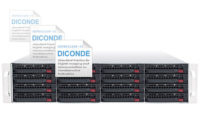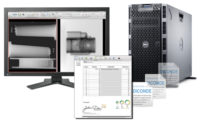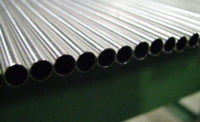NDT
Medical Imaging Technology for the Digital Transition of Nondestructive Testing
Faced with the same basic challenges of the medical industry—how to quickly and reliably store, retrieve and share images—the NDT industry was able to adopt some of the same technologies.

Driven by immense pressure to improve productivity and reduce costs, the medical industry has transitioned to digital imaging and archiving over the past two decades. Seeing the benefits of this digital transition, other industries are now following suit, leveraging the technology pioneered and proven by the highly regulated medical imaging industry.
DICOM in NDT—DICONDE
During the digital revolution in the medical industry, a single imaging standard, DICOM, emerged from the community. Digital Imaging and Communications in Medicine (DICOM) enables the integration of scanners, servers, workstations, printers and network hardware from multiple manufacturers into a cohesive picture archiving and communication system (PACS) and is now the standard for handling, storing, printing and transmitting medical imaging information. Faced with the same basic challenges of the medical industry—how to quickly, reliably and securely store and retrieve and share images—the American Society for Testing and Materials looked to DICOM for the NDT market. Given that only slight modifications were required to this proven technology to suit the NDT market (an NDT oriented superset was created, which allows “patient” tags to be replaced with “component” tags, etc.), the ASTM E07.11 subcommittee adapted DICOM, naming it DICONDE (Digital Imaging and Communication for Non-Destructive Evaluation) and ratified it in 2004 as the standard (E2339-11) for NDT imaging.
DICONDE defines all the necessary attributes and elements in a universal format so that from acquisition to transmission to archival the data is in a compatible form. This means that users can choose image viewers as well as analysis software from multiple vendors, which can easily be part of an integrated solution. The DICONDE tags also provide valuable information about the image, which can be cataloged and indexed for fast searching.
Transitioning to Digital
The digital revolution in the medical imaging field started in the 1970s with the advent of computer based image processing, but it was not until 1993 with the introduction of DICOM 3.0 that the transition to a unified imaging platform for PACS really began. The real push came from users demanding DICOM conformance in the purchasing process. Once this happened, more vendors began providing DICOM support, leading to more studies being stored digitally; however, going fully digital all at once was difficult, as costs for required upfront infrastructure, associated personnel, and workflow changes were high. As an interim step, transitional technologies to digitize film were developed, allowing prior films to be archived and viewed alongside newer acquisitions. Fast-forward to today where assistive software (based on image processing) and pattern recognition aids users in identifying possible medical issues.
For the NDT industry, a similar type of progression is expected as they transition to digital with sister technology DICONDE. As they do so, some of the lessons learned from the medical imaging transition would be beneficial to consider:
- Consistency of Data Entry.Even in the protocol driven medical imaging world, many technicians can get lax when it comes to data entry. But incorrect data entry means that prior studies may not be found, operator input-based formulas may provide inaccurate results or, worse yet, images may get associated with the wrong individual.
- Personnel Training.Different personnel skill sets are also key when transitioning to a digital workflow. As an example, film based personnel in medical imaging didn’t always have all the skills necessary for the digital transition. The need for basic computer skills and specialized training on the software involved shouldn’t be underestimated.
- Management.In the medical industry a PACS administrator position is usually created in order to manage the archiving, workflow and metadata in a digital radiology environment. These individuals need to have both the IT and imaging knowledge as they are a key player in driving protocols, being a conduit between departments, reviewing technology solutions, and managing the library of data being stored. The NDT industry should embrace this position early on as it can prevent costly long-term mistakes.
Key Benefits of Digital Archiving in NDT
With digital capability, a central repository of historical inspection data can be easily created, streamlining the overall workflow and making archiving, pre-inspection planning and post-inspection analysis quicker and more accurate. Digital capability also provides a platform for future re-analysis (with newer software tools) or assisting in root-cause inquiries.
Other key benefits include:
- Images tagged with universal metadata (e.g., part, revision, inspector, etc.), allowing for quicker image search and retrieval
- Comparison of new acquisitions quickly against reference or initial images
- Integrity verification for confident long-term image retention (possibly 20-plus years)
- Easier ability to share data including options for cloud-based storage
- Automatic image distribution based on programmable workflows
- Prefetching (automated retrieval of prior images of the same part for comparison)
- Reduction/elimination of film and associated storage, handling, and shipping cost. Savings on compliance and other environmental costs associated with using chemical-based film, as well as minimizing the impact on the environment are achieved.
- Vendor neutrality (using DICONDE as the single standard) allows for easy sharing/connecting and keep prices down (proprietary software/equipment drives prices higher as customers are held “hostage” to their suppliers)
Early adopters are already experiencing the benefits of DICONDE using it in computed radiography and direct radiography. Others in the NDT community are easing into the technology, using it to digitize their film for long-term storage while they maintain their current equipment. As use of DICONDE continues to spread, it will fast prove itself to be a cost and productivity alternative to traditional film-based systems just as its counterpart DICOM has in the medical imaging market.
Looking for a reprint of this article?
From high-res PDFs to custom plaques, order your copy today!







